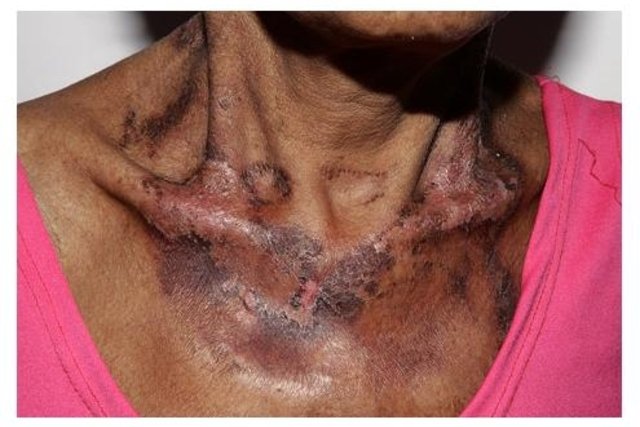Pellagra is a rare disease caused by a deficiency in the body of vitamin B3, also known as niacin, or its precursor, the amino acid called tryptophan.
This disease can cause skin changes, diarrhea and neurological changes, such as headache, mental confusion and memory loss, for example. Deficiency of this vitamin can occur due to low consumption of foods rich in this vitamin, which are mainly of animal origin, or due to changes related to intestinal malabsorption.
Therefore, it is important that the cause of pellagra is identified so that the most appropriate treatment can be initiated, which may involve changing eating habits and using vitamin B3 supplements, for example.
Sensitive content
This image may contain content that is uncomfortable for some people.

Pellagra symptoms
The main symptoms of pellagra are:
- Chronic diarrhea, where the presence of blood may be noted;
- Symmetrical lesions on the skin that is most exposed to the sun;
- Redness on the face, with a pattern similar to a butterfly wing;
- Foot injuries that do not involve the area of the foot that is normally involved in flip-flops;
- Redness and itching on the back of the hand;
- Thickening and darkening of the skin;
- Cracks appear in the feet, which can cause pain when walking;
- Loss of appetite;
- Dry, red and swollen tongue;
- Dor abdominal;
- Weakness;
- Mental confusion and disorientation;
- Memory loss;
- Mood changes.
In the presence of these symptoms, it is important that the doctor is consulted so that tests can be carried out to help confirm the diagnosis and initiate the most appropriate treatment, as if this is not done, it is possible that the person will begin to experience delusions and progress to a coma and then death due to multiple organ failure.
How the diagnosis is made
The diagnosis of pellagra is made by a general practitioner or dermatologist based on the evaluation of signs and symptoms, and blood and urine tests are also recommended to check the amount of vitamin B3 in the body.
Furthermore, in some cases it may also be recommended to perform a skin biopsy to rule out other diseases in which the same symptoms may be present.
Possible causes
According to the cause, pellagra can be classified into two main types:
- Primary pellagrawhich occurs due to insufficient consumption of foods rich in niacin and tryptophan, which is an amino acid that is converted to niacin in the body;
- Secondary pellagrawhich occurs due to changes in the absorption of vitamin B3 in the body, which may be due to excessive alcohol consumption, medication use, Crohn’s disease, malnutrition, cirrhosis and dialysis, for example.
Furthermore, some types of cancer can also favor the development of pellagra, as they can directly interfere with the metabolism of tryptophan, which is not converted into niacin.
How the treatment is carried out
Treatment for pellagra must be guided by a doctor and nutritionist according to the cause of vitamin B3 deficiency and the symptoms presented by the person.
Therefore, the use of nutritional supplements may be indicated, such as niacinamide and nicotinic acid in association with other B complex vitamins, in a dosage that must be determined by the doctor, depending on the person’s health status.
Furthermore, it is recommended to increase the consumption of foods rich in tryptophan, such as cheese, cashew nuts, almonds, eggs, peas and avocado, for example, as well as foods rich in vitamin B3, such as chicken, fish, sesame seeds, tomato and peanuts. Discover other foods rich in vitamin B3
It is also important to treat the disease that is the cause of the niacin deficiency and/or change lifestyles that may contribute to a decrease in this vitamin, such as excessive alcohol use, inappropriate use of certain medications or diets. poor in vitamins.
Bibliography
- LOPEZ Diego; OTERO Gabriela. Pellagra: an ancient disease in a modern world. Hospital Nutrition. 38. 3; 667-670, 2021
- CLEVELAND CLINIC. Pellagra. Disponível em: <https://my.clevelandclinic.org/health/diseases/23905-pellagra#symptoms-and-causes>. Acesso em 31 mar 2023
- NIH. Pellagra. Available at: <https://medlineplus.gov/ency/article/000342.htm>. Accessed on March 31, 2023
- DERMNET NEW ZEALAND. Pellagra. Available at: <https://dermnetnz.org/topics/pellagra>. Accessed on March 31, 2023
- SAVVIDOU Savvoula. Pellagra: A Non-Eradicated Old Disease. Clinics and Practice. 4. 1; 22-23, 2014
- ALVES, Andreia O.; BORTOLATO, Thaissa; FILHO, Fred B. Pellagra. The Journal of Emergency Medicine. Vol 54. 2 ed; 238-240, 2018
- JUNIOR, José Vitor O.; ZACCARIOTTO, Lílian Maria; MACIEL, Juliana N.; SITTART, José Alexandre. Pellagra. Rev Soc Bra Clin Med. Vol 6. 4 ed; 139-141, 2008
- BRAZILIAN GOVERNMENT PORTAL. What is the treatment for pellagra?. 2019. Available at: <https://ares.unasus.gov.br/acervo/html/ARES/13656/1/Telessauders_pelagra.pdf>. Accessed on 23 Jul 2020
- BADAWY, Abdulla A.-B et. al.. Pellagra and Alcoholism: A Biochemical Perspective. Alcohol and Alcoholism. Vol.49. 3.ed; 238-250, 2014

Sign up for our newsletter and stay up to date with exclusive news
that can transform your routine!
Warning: Undefined array key "title" in /home/storelat/public_html/wp-content/plugins/link-whisper-premium/templates/frontend/related-posts.php on line 12
Warning: Undefined array key "title_tag" in /home/storelat/public_html/wp-content/plugins/link-whisper-premium/templates/frontend/related-posts.php on line 13




